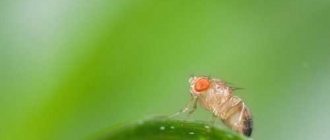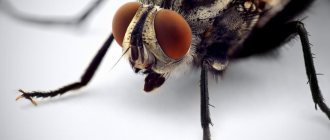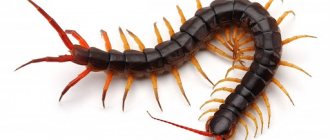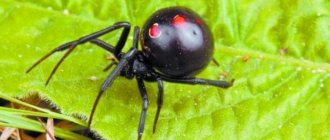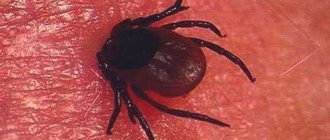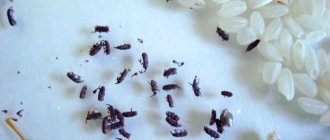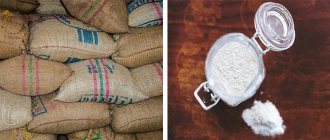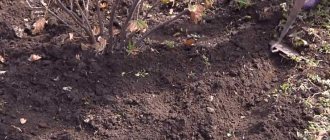These multi-legged invertebrates do not make noise, do not bite, are not aggressive, and some especially large and colorful representatives of the order are even bred by amateur enthusiasts in home terrariums. But summer residents usually look towards strange arthropods with caution - will they cause harm to the plants?
Who are these “worms”, what do they look like, where do they live, what do they eat, are they dangerous for humans or garden crops, and do we need to get rid of them? Let's sort it out in order.
Description, development, reproduction
The body color of the nodule can range from light brown to black. Their body is cylindrical or very close to this shape, like a worm, and can consist of 30 or more segments. The organs of vision are represented by two separate eyes, sometimes absent. Each segment contains two pairs of legs, with the exception of the three front ones.
Females and males have some differences in appearance. Males have homopods - modified legs that serve for external-internal fertilization. They are located in the inner part of the head segment.
When moths sense danger, they secrete a substance with a strong, unpleasant iodine odor. Many animals use this. For example, lemurs scare centipedes and then rub themselves on them to ward off predators. It has been noticed that the brighter the pest, the stronger its smell. Kivsyak can leave dark spots on the body that do not wash off for several days.
Habitats
Animals living in temperate latitudes usually live in litter - wood, grass, leaves, which also becomes their food.
Most of them are in deciduous, mixed forests, and forest-steppe zones. They rarely go to a depth of more than 30 cm. The arthropod does not tolerate direct sunlight. When cold weather sets in, the pest burrows deeper into the soil, where it remains until spring.
Stages of development
Kivsyak lays eggs in the soil. The larvae that hatch are no different from adults, only they have fewer body segments. It increases in length with each subsequent molt.
The female's fertility decreases under unsuitable conditions - low air humidity, lack of nutrition. If the conditions are favorable, then the nodule can live ten years or more.
Kivsyaki have 5 superfamilies and several families. Some species are poisonous.
Appearance of a centipede
The common flycatcher, which we call the centipede, belongs to the large family of centipedes. It has 12,000 species. The flycatcher has a flat body divided into 15 segments. Each segment corresponds to a pair of legs. The first pair, as a result of evolution, turned into jaws designed for capturing prey. It is not difficult to calculate how many legs a centipede has - 30. The number of limbs depends on the age and type of insect, the maximum number is 354. All centipedes have an odd number of pairs of legs.
The common flycatcher is usually classified as an insect, although formally it, like all centipedes, is an arthropod
Interesting fact. The last pair of legs significantly exceeds the length of the remaining limbs. In female flycatchers it is twice the size of the body. From the outside, these legs look like antennae, so at a quick glance it is difficult to determine where the insect’s head is.
The size of the flycatcher is 35-60 mm, an adult running at a speed of 40 cm/sec can make an unforgettable impression. On the sides of the head there are compound eyes. The insect has excellent vision, which helps in hunting. The long antennae of the flycatcher consist of hundreds of small segments. It has an exoskeleton of chitin and sclerotin, a distinctive feature of all arthropods.
The body of the insect is grayish-yellow with three dark stripes along its entire length. Purple stripes are also noticeable on the flycatcher's many legs. Knowing what a centipede looks like, it cannot be confused with another type of centipede - the centipede. This insect is much more dangerous; its bite is strong and causes painful swelling.
Harm and benefit
Arthropods should not be considered solely as pests. After all, in one season, grasshoppers can process up to 50% of plant waste, providing the soil with minerals and promoting the formation of soft humus. This soil is useful, for example, for rose bushes. But as soon as the moisture balance is disturbed, the arthropod turns into a malicious pest.
Kivsyak is an extremely voracious pest. During the day he eats a portion of food that is one and a half times his weight.
An animal living in the soil damages the root system of seedlings - tomatoes, cucumbers, strawberries, wild strawberries. Therefore, terrestrial organs do not receive enough nutrients. As a result, the development of plants stops, they gradually wither and die. Moreover, he will covet
In addition to roots, it feeds on strawberries and cucumbers lying on the ground or near its surface. When there is a shortage of food, centipedes can feed on green shoots and seeds. They even harm young trees - apple trees, pears, melons, tomatoes, raspberries.
Expert opinion
Mityuk Stefania Bogdanovna
Not everyone is trying to get rid of their kinks. There are people who breed them at home. Exotic lovers are attracted to invertebrates by their unusual appearance. The African species of these arthropods are especially beautiful.
Types of centipedes
Drupe mites
(Lithobius forficatus). Mobile and moisture-loving, with a well-developed sense of touch, active at night.
Red-headed drupe
(Lithobius erythrocephalus) usually lives in soil containing pine bark. Often damages orchid roots. In the wild it feeds on insects and other small animals.
Kivsyak sandy
prefers peat soil substrates. In nature it feeds on rotting plant remains.
Spotted kivsyak
(Bianiulus guttulatus) feeds mainly on decaying vegetation in gardens and forests.
Rarely, but still, geophilus and armadillo centipede damage indoor plants.
Geophilus long-whiskered
(Geophilus longicornis) has a worm-like body, 2-4 cm in length.
Centipede armadillo woven
(Glomeris soppecha) up to 1.7 cm in length, the body is wide with a hard shell. In the wild it feeds on fallen leaves.
Banded centipede armadillo
(Glomeris marginata) up to 2 cm in length. When in danger, it curls up into a ball and secretes a protective secretion. In nature, it recycles fallen leaves.
Sometimes the millipede flycatcher (Scutigera coleoptrata) settles in the house. At dusk it goes out hunting, runs along walls and hunts flies and other small insects.
It tolerates dry air better than other centipedes and is more common during the day. Although it hides in dark corners during hot sunny hours, it is not in flower pots and does not damage plants. It feeds exclusively on cockroaches, flies, mosquitoes, moths, bedbugs, crickets, spiders and other small insects.
In Crimea, the flycatcher is rare and is listed in the Red Book of Ukraine.
Pest control methods
Because of the chitinous “body armor”, it is quite difficult to fight the pest that has chosen the site.
Chemicals
In this case, they do not always bring the same effectiveness as in the fight against other pests. The reason for this is the same chitinous shell that covers the body of the invertebrate. However, chemicals can be effective against larvae that do not have a chitinous coating.
Spraying the stems and treating the seed rarely produces results. The fact is that the animal only gnaws the roots of plants.
Aktofit
The active ingredient is aversectin C. The product is used for open and closed ground, and allows you to obtain an environmentally friendly harvest. Avermectin is a neurotoxic poison produced by the soil fungus Streptornyces avermitilis. It enters the pest's body through intestinal or contact routes.
Decis
The active ingredient is deltamethrin. The drug affects the nervous system of the pest through intestinal and contact exposure. Decis acts extremely quickly - from a few seconds to several minutes.
Karate
The active ingredient is lambda-cyhalothrin. A broad-spectrum drug is used for treating plants, disinfecting areas and storage facilities. Has a pronounced knockdown effect. Can be used in tank mixtures, fungicides, insecticides, but it is worth considering the timing of use, and also make sure the compatibility of the drugs.
The application rate depends on the crop being treated. The period of protective action is from 3 to 7 days.
Zemlin
The active ingredient is diazinon. The drug is developed against soil-dwelling pests. It is mixed with sand or sawdust and placed in the ground. When planting potatoes, add 1 teaspoon of the product to each hole. Another method of application is to disperse the preparation over the soil and immediately loosen it.
Expert opinion
Mityuk Stefania Bogdanovna
As owners of summer cottages write on the Internet, the same remedies are effective against mole crickets and wireworms. Some users note that a Fas-double designed for ants will help get rid of unwanted guests.
Folk remedies
Gardeners suggest using vegetable baits. Pieces of vegetables - potatoes, carrots - are treated with insecticides and scattered around the area. The bait is changed regularly. It is better to leave pieces of vegetables under boards or plywood. This method has a drawback - it is only effective for a small population of nooses.
It has been observed that centipedes love damp places. Therefore, in order to collect them in one place, “sheds” are made of boards, under which the ground is always wet. The invertebrate emerges from the ground onto the boards in the evening, and all that remains is to collect the animals and destroy them.
How do you fight the noobs?
ChemicalPopular
Kivsyakov are lured into “compost pits”. Small trenches are dug in the garden and organic waste is left in it, which attracts centipedes.
Before collecting the pest, it is better to wear protective clothing and disposable gloves. If a foul-smelling liquid gets on clothes, it is very difficult to get rid of it, especially if we are talking about albinos.
If there are a lot of pests on the site, it is recommended to water the soil around the potato beds with a solution of calcium chloride or salt before hilling.
Centipedes in the house, why are such neighbors dangerous?
The appearance of a flycatcher in a house does not threaten its residents. The insect is more active in the dark, so the risk of encountering it will increase at night. When the light is turned on, the centipede rushes to a secluded crevice. If a centipede is spotted in a house in the summer, it is better to catch it and take it outside. You need to catch it not with your hands, but with a can or box. In tropical countries where there are no harsh winters, flycatchers do not migrate into houses.
Having settled next to a person, the insect does not encroach on his food, plants and pets. Centipedes do not chew furniture or wallpaper and are not carriers of dangerous diseases. There will also not be an invasion of large numbers of flycatchers; they do not live in families. You can get along peacefully with them, even benefiting from such a neighborhood. The little predator copes well with annoying flies, and if cockroaches are hiding in the apartment, the centipede will get to them.
Is the centipede dangerous for humans? If there is a clear threat to life, such as a pet or human attack, it may bite and inject venom under the skin. A small dose of a paralyzing toxin is not lethal to pets, much less to people. It causes an unpleasant sensation, but no more than a bee sting. A tendency to be allergic to insect venom can aggravate the situation, causing swelling and general malaise.
Do centipedes bite?
Even the most non-aggressive creature can bite out of fear. A flycatcher, even if it attacks an adult, in most cases will not be able to bite through the skin. Children's skin is more delicate and thin, so getting wounds is real. Symptoms of toxin entering the body include redness, itching and burning. What to do if bitten by a centipede? The first piece of advice is don't panic. The poison is very weak and will not cause any harm to health. It is worth acting according to the circumstances:
- disinfect the wound with alcohol or hydrogen peroxide;
- if there is a strong burning sensation and swelling, you should apply a cold compress and hold it until the discomfort disappears;
- if the bite site hurts, take an antihistamine and pain reliever.
Attention. Individual intolerance to flytrap venom can lead to complications. If symptoms of an allergic reaction appear - weakness, dizziness, breathing problems and others, you should go to the hospital.
How to get rid of a flytrap
Not everyone likes the presence of an unpleasant insect in the house, which can fall from the wall directly onto anyone’s head. Many people are afraid of a centipede bite and its consequences. A change in the conditions that are comfortable for it can force the common flycatcher to leave its favorite place. Simple and affordable actions against centipedes:
- The flycatcher loves dampness - it is necessary to ensure a normal level of humidity. Wipe up puddles on the floor in a timely manner, fix leaking taps, and do not leave wet wipes or rags on.
- Airing and good ventilation also reduce humidity in the room.
- Check the basement; there is often an accumulation of rotten boards, old paper, mold and dampness.
- Try to deprive the flytrap of food, destroy flies, cockroaches and other prey yourself.
- Block possible routes of entry into the house - fill cracks with mortar, put screens on windows, repair cracks in the wooden floor.
Attention. Sticky insect traps placed on the floor will not help get rid of the common flycatcher. She runs away from the tape, leaving several detached legs on the surface. This is a small loss for the centipede, because the legs grow back over time.
The centipede or flytrap is not the most pleasant neighbor, but it is useful. Various insect parasites exist hidden in every home. The predatory centipede effectively destroys pests. If you ignore her repulsive appearance, it will be a mutually beneficial partnership.
Prevention
It is easier to prevent kiwis from entering the garden than to get rid of them later. Therefore, you need to follow these site processing rules:
Liming the soil to a depth of 20 cm will help clean the soil from the pest.- After harvesting the autumn harvest, plant residues, especially weeds, are removed from the soil before planting crops.
- Late autumn plowing and earlier spring cultivation raises heat-loving pests - they die from the cold.
- From time to time it is useful to sow green manures - green fertilizers - on the site. In this capacity, you can use white mustard, yellow lupine, peas, and sunflower.
- Mulching and agrofilm will protect ground crops from pests.
- Organic fertilizer (manure, humus) must be carefully inspected before applying to the soil, since the pest can enter the site in this way.
Lime consumption rates for liming (kg/sq. m):
| Acidity, pH | Clay, loam | Sands, sandy loam |
| Less than 4.0 | From 0.5 | 0,35 |
| 4,1…4,5 | 0,4–0,5 | 0,25–0,3 |
| 4,6…5,0 | 0,3–0,4 | 0,2–0,4 |
| 5,1…5,5 | 0,3…0,25 | They don't contribute |
| 5.5 and above | They don't contribute | They don't contribute |
Before liming the soil, it is necessary to clarify the conditions for growing the crop. If you need acidic soil, then it is better to avoid liming, since the pH increases after such treatment. Such crops include, in particular, rhododendron, blueberries, azaleas, and potatoes. Also, you cannot add lime at the same time as digging up green manure.
All construction waste must be removed from the garden - boards, slate, bricks. Invertebrates usually live in these mini-dumps.
The fruits of strawberries and cucumbers will not be damaged if you tie up the vines and install supports. Water the soil moderately and do not over-moisten it. The harvest is harvested in a timely manner, without allowing the fruits to fall off.
As already mentioned, grasshoppers start in manure heaps and compost pits. To prevent the pest from entering the garden, the fertilizer must be prepared correctly. So, the manure pile needs to be watered and mixed. Then a temperature of 60°C or higher is created inside, causing the centipede to die.
When preparing composts, the components - food waste, peat, sawdust, etc. - are stacked in layers, each sprinkled with superphosphate, potassium chloride or watered with a solution of table salt (take 1 liter of salt per bucket of water).
Owners of summer cottages noticed that centipedes crawl out of the ground in the rain, like worms. After a rainstorm, they can be collected by hand and destroyed.
Habitat
The common flycatcher can be found in many temperate regions. In Russia, this is the Volga region, the southern regions, the insect lives in the northern part of Africa, Europe, the Middle East, and Mediterranean countries. Under natural conditions, centipedes hide under stones, fallen leaves, and plant remains. The domestic centipede hunts at any time of the day.
They move to human housing with the onset of autumn cold weather. Prefer dark and damp places:
- basement;
- bathroom;
- toilet.
During the winter, the insect hibernates and becomes active only when the weather warms up. In southern countries, centipedes are treated kindly, because they help exterminate pests.
How to get rid of it?
If you fertilize the soil with manure, it is advisable to carefully review whether it is contaminated before purchasing.
You should also pay attention to the following measures to combat centipede pests:
- Remove all weeds from the soil.
- Before planting, soak the seeds for a while in a solution of manganese and water. This will eliminate plant disease, the process of rotting that attracts pests so much. The seeds can also be treated with pyrethroids.
- After finishing the summer season, treat the soil in greenhouses for disinfection using special thermal methods.
- At the end of autumn, plow the garden to disrupt the amenities of adults and larvae of the nooses that have prepared to spend the winter. Once on the surface in cold weather, they can freeze.
- To prevent the proliferation of centipedes, add lime, ash, chalk, eggshells, and dolomite flour to the soil.
- Plant green manure in the vacant areas of the garden. For example, oats, buckwheat, phacelia. This will not only drive away pests, but will get rid of weedy plants.
- Immediately remove fruits marked with nods.
- If the soil is heavily contaminated, then you need to use chemicals such as “Grom2”, “Decis”, Counter”, etc. Or simply treat the soil with a solution of chloride salt (ecological method). Such drugs as “Actofit” and “Karate” are especially effective on larvae, since their shell is not yet strong and allows the insecticide to pass through. Treatment should be carried out at sunset, when centipedes crawl out of their shelters.
- Use poison baits mixed with some root plants.
- Place boards between planting beds from time to time. The bait works like this: when it’s hot and dry outside, pests crawl under the boards, where shade and moisture are retained. By removing the tree, you can quickly destroy the nooses.
- Dig small holes, 7-8 cm deep, and insert empty containers there (preferably ones that can then be covered with a lid). Wandering from place to place, the pests will fall into the trap.
Mechanical means of destruction
The most popular means of getting rid of centipedes today are traps using pieces of root vegetables. In this case, the food in the baits is treated with suitable insecticides and scattered in different corners of the crop area. This method takes quite a lot of time, because it will require constant moistening and updating of the bait.
Baits can be used in other ways. It is necessary to dig compost-like pits and make them as attractive as possible for centipedes - filling the space with various garden waste is suitable for this.
It is worth noting that the efficiency will increase significantly if the contents of such pits are treated with sodium and potassium salts - a moistened, mixed mixture of this type, covered with a layer of turf, will create unfavorable living conditions.
Experts still recommend not destroying arthropods, because the centipede is not the most dangerous garden pest. It is best to catch and release it in the far corners of the site. It does a pretty useful job, turning rotten wood and leaf debris into fertile soil.
Insects in the garden
The nooses do not crawl far from food sources.
They lay eggs near the place where the larvae live and feed. Most often they can be seen near plantings with strawberries or cucumbers. Also, manure heaps are favorite places for them to accumulate.
Long-bodied creatures are especially harmful to plants if spring is cold and wet. Then plant growth slows down, and the root system becomes the main source of nutrition for the worms. The culture becomes dark gray or black, and then may dry out completely. Strawberries are most often affected by centipedes. The pest makes funnels and tunnels in its berries. Sometimes you can see larvae in the middle. They prefer rotten fruits and vegetables, but they also do not disdain fresh and whole ones. The factor of proximity to the ground plays a fundamental role when choosing a target in centipedes.
It is not necessary to look for a spotted representative of terrestrial invertebrates in the garden. Gray, sandy, and Crimean grasses, the shades of which can be both dark and light, can spoil your plants. All centipedes have a body with many segments and a pair of legs on each of them.
Centipedes can start anywhere. Their appearance is not affected by open or closed ground. But in greenhouses, reproduction occurs at high speed due to humidity and warm temperature.
How to fight
The fight against moths is carried out using several methods; we will consider them below.
As a preventive measure, it is recommended to dig up the area in late autumn, when frosts begin at night. Then heat-loving pests, including nodule, will die. You should also clear the garden of weeds and unnecessary objects so that they do not serve as shelter for centipedes. It is recommended to tie the strawberries to supports so that the strawberries do not reach the berries.
There are some organizational and preventive techniques aimed at saving the harvest from the millipede nod:
- liming of the earth;
- use of rotted compost and manure, control over their biological composition;
- Plowing in late autumn and cultivating in early spring contributes to the freezing of the grass.
Did you know? Each year, the adult renews its armor and adds one additional segment. Thus, the number of legs constantly increases from 100 to 400 pairs.
Using baits
This method of fighting is the most popular. Centipedes are fed with root crops treated with insecticides. However, this method is quite troublesome, because it is necessary to constantly renew, moisten the bait, and collect fish. Sometimes this method is complicated by installing containers into which centipedes crawl; it is necessary to clean these shelters from time to time. The bait method is good when nods live in a limited area; if there are several colonies, then it becomes ineffective.
